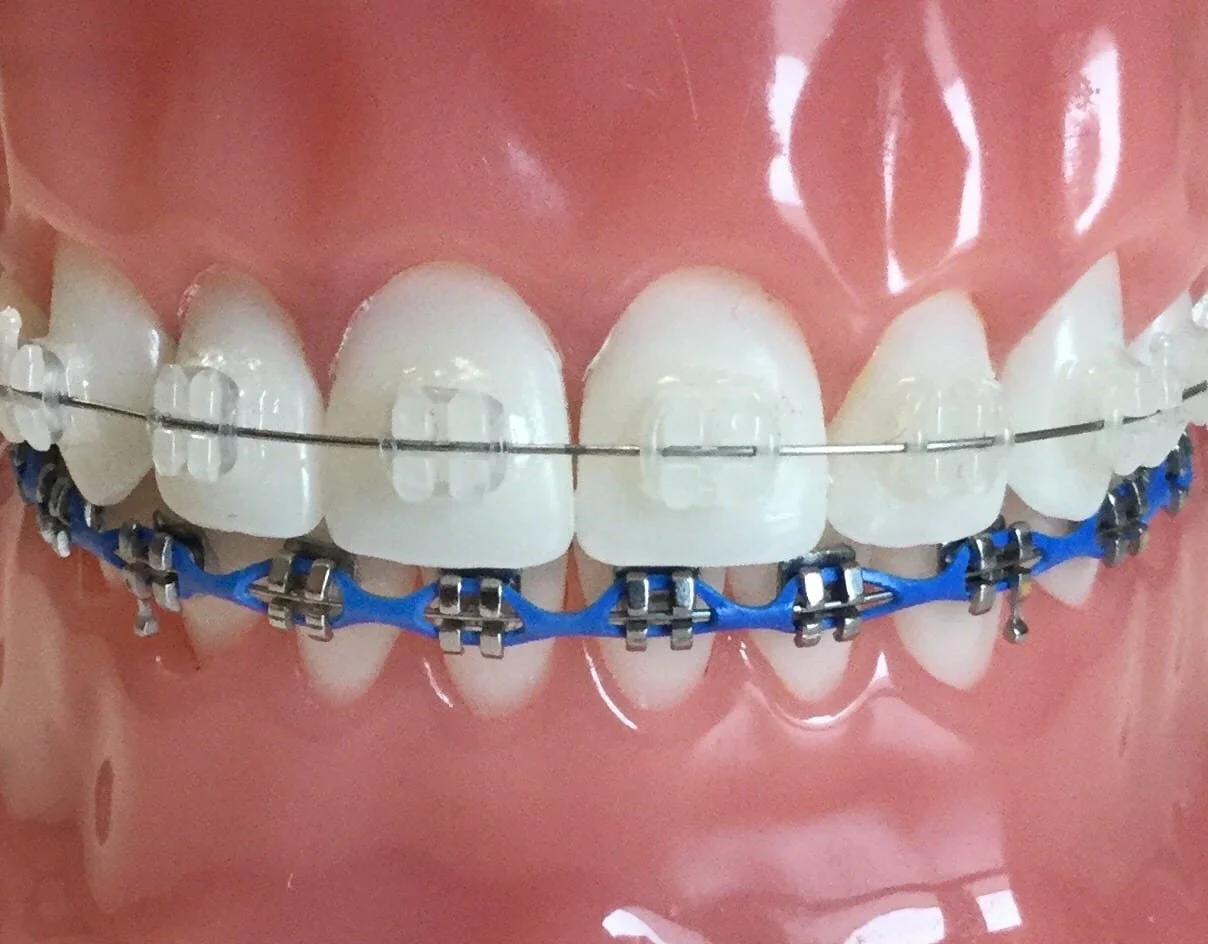What are Ceramic Braces?
Ceramic braces, also called clear braces, use clear or tooth-colored brackets made of polycrystalline alumina that blend in with the teeth, making them subtler and less noticeable than metal braces. The connecting wire can also be tooth-colored to further decrease the visibility of ceramic braces.
Ceramic braces are often preferred over metal braces by older teens and working professional adults who want to straighten their teeth without the appearance of metal braces. Invisalign is also a great option for this if their treatment plan will allow it.
They tend to stain more easily, due to the lighter color of the brackets, so avoiding dark beverages like coffee and red wine is important. In addition, they generally cost more than traditional metal braces.
The Materials of Ceramic & Metal Braces

Ceramic braces and metal braces use a similar design to achieve straight teeth and a healthy smile, but the major difference is the material the brackets are made from.
Metal braces use brackets made of medical-grade stainless steel, while ceramic braces use a polycrystalline alumina that can either be clear or the same color as your tooth. The stainless steel is extremely noticeable against the white of your teeth, so ceramic brackets are appealing for their discreet appearance. They are also called clear braces, since the brackets can be transparent.
The flexible metal archwire that connects the brackets can also be made of a lighter color for ceramic braces, including white, silver, or a frosted tone that matches the brackets. The combination of tooth-colored brackets and archwire means that your ceramic braces may be nearly invisible to others, which makes this option popular for working adults or college students who want straight teeth without the “metal mouth” look.
There are genuine cosmetic benefits to ceramic braces, but there are also drawbacks when compared to metal braces. Ceramic braces are less durable than metal braces, as the bracket material isn’t as strong as stainless steel. Studies have found clear/ceramic braces are more than twice as likely to break off or fracture as metal brackets. This makes care and compliance extremely important: you can’t eat any crunchy foods or hard candies with ceramic braces, for risk of breaking.
Ceramic brackets are also more likely to stain, due to their lighter color. Ceramic or clear braces users should limit their intake of dark foods and beverages like coffee, tea, red wine, ketchup, curries, etc. All of these can stain or discolor the clear or tooth-colored brackets. As a solution, you can drink through a straw or brush your teeth immediately afterwards to reduce the risk of staining.
If ceramic braces are placed on lower front teeth, the bracket can cause wear and tear of the enamel on the back side of the upper row of teeth when biting or chewing food, due to the abrasive nature of the material from which they are constructed. For certain patients, especially those with excessive overbite, it may be more effective to get metal braces on the bottom teeth.
Finally, another big difference is cost: ceramic or clear braces almost always cost more than metal braces, due to the more delicate, expensive material the brackets are made from. Ceramic braces cost between $3,000 and $7,000, whereas metal brackets cost between $1,700 to $6,000. This price includes the appliance, the cost of in-office visits to the orthodontist, and follow-up care like retainers.
To summarize: the biggest advantage of ceramic/clear braces is the discreet, subtle appearance, since they blend in so seamlessly with your smile. While there are certain disadvantages that may make metal braces more attractive, for many people, this cosmetic feature is the most important, so ceramic braces are the clear choice!
PROS & CONS
Ceramic Braces: Pros
-
-
-
Discreet clear or tooth-colored brackets are nearly invisible to others
-
Same effective, reliable technology as metal braces
-
Increased confidence from improved smile without the “metal mouth” look
-
Lower cost than Invisalign clear aligners for a similarly discreet look
-
May be more comfortable than metal braces, smoother feel of brackets
-
-
Ceramic Braces: Cons
-
-
-
More delicate and more likely to break than metal brackets
-
Higher cost than metal braces
-
More likely to stain due to lighter colored brackets
-
May cause damage to the top teeth when worn on the bottom teeth. We recommend our patients don’t wear ceramic on their bottom teeth because of this.
-
-
Who Should Get Ceramic Braces?!

If you are interested in straightening your teeth but don’t want the look of metal braces, ceramic braces are a great option. They are preferable to metal braces for many older teens and adults, who want a discreet orthodontic option. For working professionals or college students, ceramic or clear braces provide all the effectiveness of metal braces, without the “metal mouth” appearance that we often attribute to younger teens.
Because ceramic braces stain more easily, they are best for those responsible enough to avoid certain foods and beverages and care for their braces properly. And due to their higher price point, those interested in ceramic braces should consider whether it is worth the cost for the benefit of discreet treatment.
Ceramic or clear braces aren’t for everyone, but if you’re looking for reliable, effective orthodontic care you may want to consider ceramic braces. Click the button below to schedule a consultation with our specialists to learn the best treatment options for you.
